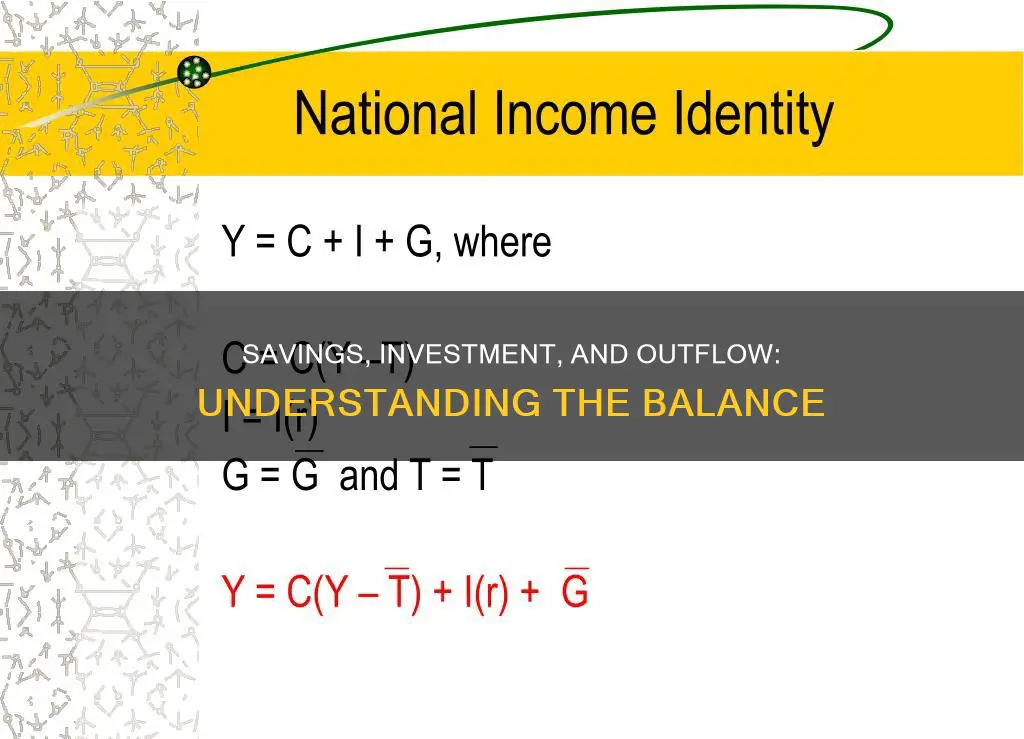
The relationship between savings, investment, and net capital outflow is a fundamental concept in economics, particularly in understanding a country's trade balance and financial capital dynamics. Net capital outflow refers to the difference between domestic residents' acquisition of foreign assets and non-residents' acquisition of domestic assets, influencing the exchange of currencies and investment opportunities. In an open economy, the market for loanable funds, where savers deposit their savings and individuals or entities seek loans, plays a crucial role in understanding this relationship. The equilibrium in this market is reached when savings are equal to domestic investment and net capital outflow. This equilibrium is influenced by the real interest rate, which affects the attractiveness of domestic assets to foreign investors.
A country's trade balance, determined by its investment and saving choices, also impacts net capital outflow. A trade deficit occurs when imports exceed exports, requiring a country to borrow from abroad, resulting in a net capital inflow. Conversely, a trade surplus leads to a net capital outflow as excess financial capital is invested in other countries.
The interplay between savings, investment, and net capital outflow is complex and subject to various economic shocks and policy decisions. Changes in interest rates, budget deficits, trade policies, and political instability can all influence this relationship, ultimately impacting a country's financial capital dynamics and exchange rates.
| Characteristics | Values |
|---|---|
| Definition of Net Capital Outflow | The difference between the acquisition of foreign assets by domestic residents and the acquisition of domestic assets by non-residents |
| Relationship between Net Capital Outflow and Foreign Currency Exchange | Net capital outflow links the market for loanable funds and the market for foreign currency exchange |
| Relationship between Net Capital Outflow and Interest Rates | A rise in the world interest rate will increase savings and reduce investment, increasing the net capital outflow |
| Effect of Budget Deficits | A government budget deficit reduces the quantity of available loanable funds, shifting the supply curve to the left and increasing the real interest rate, which reduces net capital outflow |
| Effect of Trade Policies | Trade policies do not affect the trade balance, although they can cause appreciation or depreciation of the domestic currency |
| Effect of Political Instability | Political instability can lead to capital flights, increasing the demand for loanable funds and the supply of domestic currency, resulting in a higher real interest rate |
What You'll Learn

The relationship between savings, investment, and net capital outflow
Savings and investment are two sides of the same coin in a country's economy. Savings refer to the income that is not spent on consumption, while investment involves allocating resources to produce goods and services in the future. The interaction between these two factors is crucial for a country's economic growth and stability.
Net capital outflow, on the other hand, refers to the net flow of financial capital out of a country. It is the difference between the amount of financial capital leaving a country through investments, purchases of foreign assets, or lending, and the amount of financial capital entering the country through similar channels.
A country's net capital outflow is closely linked to its savings and investment levels. When a country's investment exceeds its savings, it leads to a net capital inflow, indicating that the country is borrowing from abroad to finance its investments. Conversely, when a country's savings exceed its investment, it can lead to a net capital outflow as the excess savings are lent to foreign countries or invested internationally.
Additionally, the balance of payments, which includes the current account and the capital account, plays a crucial role in understanding the relationship between savings, investment, and net capital outflow. The current account reflects a country's net exports of goods and services, net investment income, and net unilateral transfers. The capital account, on the other hand, records the trade in existing assets between countries. The sum of these two accounts always equals zero, indicating that inflows of capital will be offset by outflows, and vice versa.
In summary, the relationship between savings, investment, and net capital outflow is intricate and dynamic. A country's net capital outflow is influenced by its savings and investment levels, which, in turn, are affected by factors such as the world interest rate and the balance of payments. Understanding this relationship is essential for policymakers and economists to make informed decisions regarding fiscal and monetary policies, international trade, and economic growth.
529 Savings Plans: Smart Investment Strategies, per Forbes
You may want to see also

How savings and investment determine the trade balance
Savings, investment, and trade balance are interconnected and influence a country's economic health and position in the global market. Here's how savings and investment determine the trade balance:
The Relationship Between Savings, Investment, and Trade Balance
The relationship between savings, investment, and trade balance can be understood through the equation:
> S = I + (G – T) + (X – M)
Where:
- S represents domestic savings, including both private and public savings.
- I stands for domestic investment, such as business investments in capital goods and inventory changes.
- G represents government expenditure on finished goods and services.
- T represents the taxes the government collects.
- X denotes exports, or the value of goods and services sold to other countries.
- M denotes imports, or the value of goods and services bought from other countries.
In this equation, the trade balance (X – M) is influenced by the balance between domestic savings (S) and domestic investment (I). When a country's domestic savings exceed domestic investment, it can result in a positive trade balance, indicating that the country is exporting more than it imports. Conversely, when domestic investment surpasses domestic savings, it can lead to a negative trade balance, or a trade deficit.
The Impact of Savings on Trade Balance
An increase in domestic savings can contribute to a more positive trade balance. This is because higher savings can lead to a reduction in the need for foreign financial capital to fund investments. As a result, the country may experience a decrease in its trade deficit or an improvement in its trade surplus. This relationship is particularly relevant for countries with low savings rates, as increasing their savings rate can have a more pronounced effect on their trade balance.
The Role of Investment in Trade Balance
Domestic investment plays a crucial role in determining the trade balance. When domestic investment exceeds domestic savings, the country needs to source capital from abroad, resulting in a trade deficit. On the other hand, if domestic savings surpass domestic investment, the excess financial capital can be invested in other countries, leading to a trade surplus. Therefore, fluctuations in investment levels can directly impact the trade balance.
Government Spending and Taxation
Government spending and taxation policies also influence the trade balance. When the government runs a budget deficit (G – T < 0), it borrows from the supply of savings, acting as a demander of financial capital. This can contribute to a trade deficit as the government sources funds from abroad. Conversely, when the government has a budget surplus (G – T > 0), it contributes to the supply of financial capital, potentially improving the trade balance.
Interest Rates and Trade Balance
Interest rates can also impact the relationship between savings, investment, and trade balance. A rise in the world interest rate can lead to decreased investment and increased savings in a country, reducing its net import of capital. Conversely, a fall in the world interest rate can stimulate investment and reduce savings, increasing the net capital inflow.
Macroeconomic Analysis
From a macroeconomic perspective, the connection between trade balances, savings, and investments is crucial. The national saving and investment identity highlights that a country's own levels of domestic savings and investment are fundamental determinants of its balance of trade. This relationship transcends the performance of specific sectors or trade policies and underscores the macroeconomic nature of the trade balance.
Example Scenarios
To illustrate the impact of savings and investment on the trade balance, consider the following scenarios:
- Increased Domestic Investment: If a country experiences a surge in domestic investment while private and public savings remain unchanged, the trade deficit will likely increase. This is because the additional financial capital for investment will need to come from abroad, leading to a higher trade deficit.
- Increased Domestic Savings: Conversely, if domestic savings increase while domestic investment and public savings remain constant, the trade deficit will tend to decrease. Higher domestic savings reduce the reliance on foreign financial capital, improving the trade balance.
- Government Budget Deficit: When the government budget deficit increases significantly, it leads to higher demand for financial capital. Consequently, the trade deficit is likely to rise as the government borrows more from foreign investors.
In summary, a country's trade balance is intricately linked to its domestic savings and investment dynamics. The interplay between these factors shapes the country's position in the global market and its ability to maintain a positive trade balance or manage a trade deficit.
S-Corp Savings: Investing for Growth and Security
You may want to see also

The impact of economic shocks on savings and investment
Economic shocks can have a significant impact on savings and investment, with consequences for various sectors of the economy. These shocks can be sudden and unpredictable, stemming from factors outside conventional economic models. They can be categorised as either supply shocks or demand shocks, and they can further be classified as real or nominal, depending on whether they arise from changes in actual economic activity or alterations in the nominal values of financial variables.
Impact on Savings and Investment
Supply Shocks
Supply shocks disrupt the production process, making it more challenging and costly for industries to operate. For example, a surge in oil prices can lead to higher fuel costs for businesses. Natural disasters, such as hurricanes or earthquakes, can trigger supply shocks, as can man-made events like wars or acts of terrorism. These shocks can affect savings and investment by making it difficult for businesses to maintain their current level of operations and forcing them to cut back on investment plans.
Demand Shocks
Demand shocks occur when there is a sudden shift in consumer spending or business investments. For instance, a decline in stock or home prices can lead to a negative demand shock as households reduce their consumption. Demand shocks can impact savings and investment by causing businesses to reevaluate their investment plans and potentially cut back on expansion or research and development.
Financial Shocks
Financial shocks originate from the financial sector and can affect all industries due to the modern economy's reliance on liquidity and credit. Examples include stock market crashes, liquidity crises, and rapid currency devaluations. These shocks can have a direct impact on savings and investment by affecting the availability of credit and the cost of capital.
Policy Shocks
Policy shocks result from changes in government policies and can be intentional or unintentional. Fiscal policy changes, such as tax cuts or government spending initiatives, can act as demand shocks. The imposition of tariffs and trade barriers is another example of a policy shock, which can positively or negatively impact different sectors. Policy shocks can influence savings and investment by changing the economic landscape and affecting businesses' investment decisions.
Technology Shocks
Technology shocks arise from technological advancements that affect productivity. Positive technology shocks, such as the introduction of new technologies, can increase productivity and have a beneficial impact on savings and investment. However, negative technology shocks, such as rising energy prices, can also occur and impact the cost structure of businesses, potentially affecting their savings and investment plans.
Examples of Economic Shocks and Their Impact
Oil Price Shock in the 1970s
The oil price shock of the 1970s, caused by geopolitical tensions in the Middle East, is an example of a supply shock. It led to soaring fuel costs, affecting industries reliant on oil and resulting in inflation and unemployment.
Global Financial Crisis in 2008
The Global Financial Crisis of 2008 was a financial shock that sent shockwaves through the global economy. It involved the collapse of major financial institutions, a credit market freeze, and a housing market crash. This shock had a significant impact on savings and investment, with many businesses and individuals losing access to credit and being forced to cut back on spending and investment.
COVID-19 Pandemic
The COVID-19 pandemic is a recent example of a demand shock, with lockdowns resulting in a massive reduction in consumer spending. This shock affected the savings and investment behaviour of both individuals and businesses, as many were forced to reduce their spending and investment plans to cope with the economic downturn.
Resilience and Recovery
It is important to note that economies have a remarkable ability to adapt to and recover from economic shocks. This resilience can be seen through adjustment mechanisms, such as businesses investing in more energy-efficient technologies, and government interventions, such as fiscal and monetary policies to stabilise the economy.
How to Make Your Savings Work for You
You may want to see also

The role of government budget deficits
The national saving and investment identity is a framework that illustrates the relationship between the supply and demand of financial capital in an economy. It is founded on the principle that the quantity of financial capital supplied in a market must be equal to the quantity demanded. This identity helps elucidate the role of government budget deficits in the context of savings, investment, and net capital outflow.
When a government runs a budget deficit, it spends more than it receives in taxes, resulting in negative public savings. Consequently, the government becomes a demander of financial capital, borrowing funds to finance its expenditures. This shift in the government's position from a supplier to a demander of financial capital has implications for the overall equilibrium within the national saving and investment identity.
A budget deficit can influence either private savings, private investment, the trade balance, or a combination of these factors. Firstly, an increase in the budget deficit may lead to a rise in private savings. This occurs when individuals and firms choose to save more in response to the government's increased borrowing. Secondly, the budget deficit may cause a fall in domestic investment. As the government borrows more, it competes with the private sector for limited financial capital, potentially leading to a decline in private sector investment. Thirdly, a rising budget deficit can contribute to a widening trade deficit. If the government borrows from foreign investors, it increases the inflow of foreign financial capital, resulting in a higher trade deficit.
On the other hand, a reduction in the government budget deficit can have opposite effects. A decrease in the budget deficit may lead to a fall in private savings as individuals and firms have less incentive to save. Additionally, a lower budget deficit can result in an increase in domestic investment as the private sector faces less competition for financial capital. Finally, a shrinking budget deficit may contribute to a reduction in the trade deficit, particularly if the government borrows less from foreign investors.
It is important to note that the specific outcomes of changes in the government budget deficit depend on various economic factors and policies. The national saving and investment identity provides a framework to understand these relationships, but the actual impact on private savings, investment, and the trade balance can vary based on other economic conditions and policies implemented by the government.
Maximizing UK Savings: Investment Strategies for Beginners
You may want to see also

Trade policies and their effect on the trade balance
Trade policies are the set of agreements, regulations, and practices by a government that affect trade with foreign countries. They can be used to encourage more trade through open trade policies or to restrict trade to protect local industries from competition.
Trade policies can include regulations, tariffs, and quotas. They can have a number of benefits, including economic growth and lower costs of goods. For example, the US-Mexico-Canada Agreement (USMCA) is a trade agreement that aims to eliminate trade barriers between the US, Mexico, and Canada while including some restrictions on imports and exports.
On the other hand, protectionist policies can include setting quotas on the number of imported goods, imposing tariffs, and offering subsidies to domestic producers. These policies can distort the economy and create excessive and possibly unsustainable imbalances.
According to IMF research, most changes in bilateral trade balances over the past two decades were driven by macroeconomic factors rather than tariffs. These factors include fiscal policy, demographics, weak domestic demand, exchange rate policies, and domestic supply-side policies. While changes in tariffs can hurt output, jobs, and productivity, they play a smaller role in influencing trade balances.
In summary, trade policies can have a significant impact on a country's trade balance, with protectionist policies restricting trade and open trade policies encouraging it. However, it is important to note that macroeconomic factors also play a crucial role in determining trade balances.
Reviving Nature: Planting vs. Preservation, Where Should We Invest?
You may want to see also
Frequently asked questions
A country's national savings is the total of its domestic savings by households and companies (private savings) as well as the government (public savings). The demand for financial capital (money) represents groups that are borrowing the money, such as businesses and the federal government. The supply of financial capital must equal the demand for financial capital. Net capital outflow is the difference between the acquisition of foreign assets by domestic residents and the acquisition of domestic assets by non-residents.
The formula for calculating net capital outflow is:
Net capital outflow = national saving – domestic investment.
An increase in the world interest rate will increase savings and reduce investment, thereby increasing the net capital outflow. Conversely, a decrease in the world interest rate will lead to reduced savings and increased investment, resulting in a decrease in the net capital outflow.
When a country's investment exceeds its savings, it becomes a net importer of capital, experiencing a net capital inflow. This means that the country is borrowing from abroad to finance its investment, which can create a trade deficit and foreign debt.







